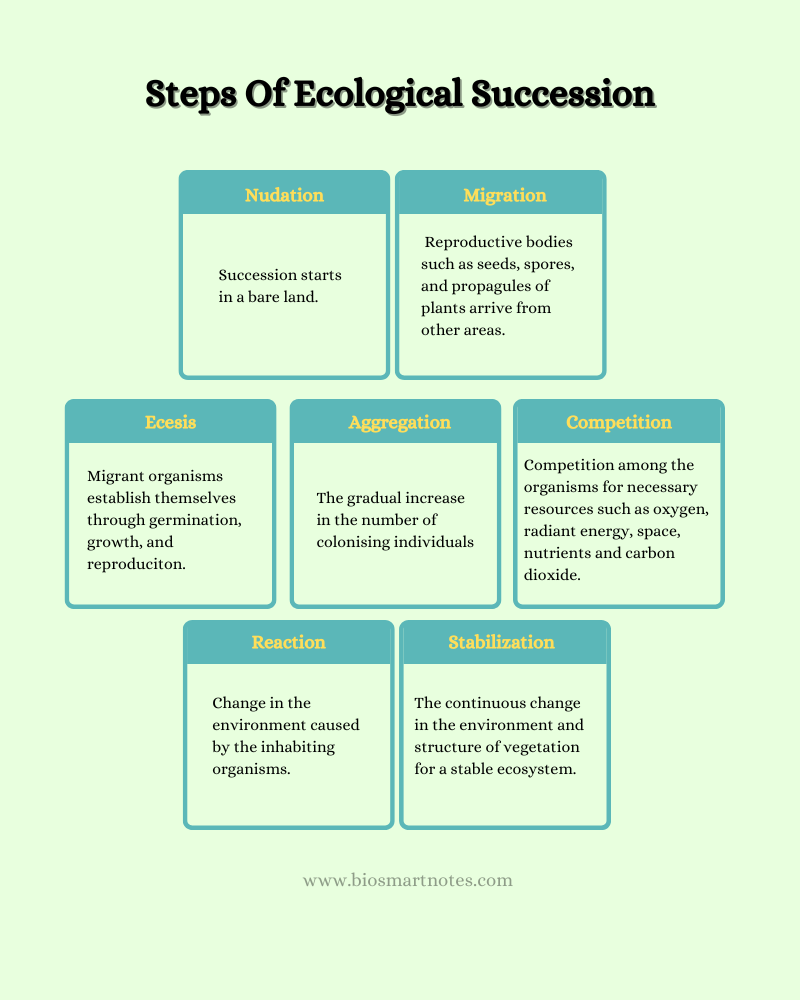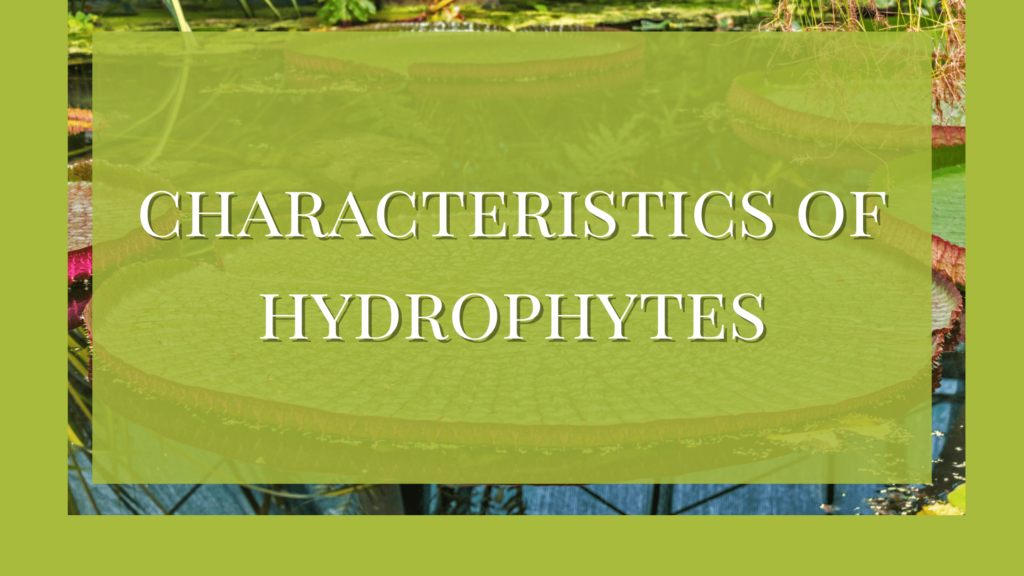Ecological succession is the gradual evolution of species of organisms from one form into another. It is a rather slow process that takes thousands of years.
Mechanism Of Ecological Succession
Various factors influence the initiation of succession as well as the subsequent interactions in a community. The community passes through the appearance and disappearance of different communities before it can attain stability. The various processes or stages that a community passes through remain the same. This evolution passes through 7 different stages such as
- Nudation
- Migration
- Ecesis
- Aggregation
- Competition
- Reaction
- Stabilization
Steps Of Ecological Succession
Nudation
Nudation refers to the commencement of development in a bare land with no life. Here creation occurs due to the physiographic, climatic, or biotic agents.
Physiographic agents
The actions of wind, water, gravity, volcanoes, etc can gradually bring about erosion or deposition of soil particles. Erosion takes away fertile soil particles, plants, animals, etc, and their organic remnants. Deposition on the other hand brings in sand, silt, gravel, debris, mud, and volcanic products that can destroy the existing communities. Both scenarios make way for another succession.
Climatic agents
The action of wind, hail storms, snow, drought, lightning etc can destroy the existing vegetation. Such destruction may not be complete but strong wind can lead to the breakage of plants or uprooting them.
Hail can destroy the foliage, fruits, or flowers. Long-term drought and heavy rainfall can completely eliminate the vegetation. Drought leads to evaporation of water from ponds and lakes. Lightning causes fire which can completely remove vegetation from an area.
Biotic agents
Humans are a major cause that produces bare areas through deforestation, cutting of plants, clearing the area of cultivation, building new rails and roads, residential or industrial complexes, etc. The expulsion of poisonous fumes and waste material leads to the destruction of vegetation in nearby and faraway areas. Overgrazing, epidemics, etc also lead to the formation of bare areas.

Migration
Migration means the arrival of reproductive bodies such as seeds, spores, and propagules of plants from other areas. It is also known as an invasion. This is made effective by wind, water, and animals. When these reproductive bodies fall on the bare area where they will germinate and grow.
The nature of the bare area determines the type of plant that can grow there. For example, on bare rocks, seeds and spores cannot germinate but the soredia of lichens can stick to the depressions and crevices of the rock, sometimes even on the bare surfaces. They can germinate to form a new lichen, usually crustose lichens initially and later fruticose lichens.
In case the bare area is a pond, the seeds of only water plants can germinate whereas in a desert, only the seeds of xerophytic plants can grow. So the condition of the bare area determines the type of the initial vegetation it can afford to grow.
Ecesis
The process by which the migrant organisms adjust and establish themselves in a new area after migration is called ecesis. It consists of three processes.
- Germination
- Growth
- Reproduction
These processes are dependent on climatic, edaphic, and biotic factors. The success of plants depends on the dormancy of seeds or their capacity to remain dormant during unfavorable conditions.
The next stage is the successful establishment of seedlings. The seedling should withstand adverse conditions like drought, temperature, light, water, etc. There could also be the possibility of seedling damage caused by insects, birds, animals, pathogens, etc. If the seedling can survive, it grows further and reaches maturity to complete the process of ecesis.
Ecesis is deemed complete when the organism is capable of reproducing sexually in its new environment.
Aggregation
Aggregation is the gradual increase in the number of colonizing individuals. In the beginning, the pioneers are few and they grow far from one another. They produce flowers, fruits, and seeds. These seeds germinate into seedlings and seedlings grow into new plants so that the number of individual members increases. The increase in population is affected by the vegetative propagation methods as well. Such an increase in the overall number of species in a unit area is called aggregation.
Competition
As the population of organisms increases, there will be an eventual competition for necessary resources such as oxygen, radiant energy, space, nutrients, and carbon dioxide. Competition involves this struggle for existence between two or more individuals growing in an area, usually between plants of the same kind that may exert demands that are similar on the soil. Examples of this struggle are the one between different lichens, shrubs, or herbs but never between a tree and a lichen.
The competition may be interspecific, between individuals of different species, intraspecific, or within the same species. The struggle may be for light in the Mediterranean (above the soil surface), for moisture between subterranean parts such as roots, etc.
As a result of this competition, weak individuals are eliminated and stronger ones are retained. The dead bodies of eliminated plants decay and form humus to enrich the soil.
Reaction
Reaction is a biotic course of succession that includes the effect of plant growth on its habitat. Thus it is the change brought about by colonisers in that habitat. It includes changes such as the binding of soil particles assisting in weathering, growth of soil microorganisms, etc.
The plants alter the habitat conditions. For example, they draw raw materials from the environment in large amounts and return metabolic wastes. This waste accumulates in large amounts and differs from the original raw materials. This alters the environment.
But with their death and decay, pioneers increase the organic matter, moisture, and nitrogen content of the soil. The reaction of early colonizers is such as to make the habitat less favorable for themselves and more favorable for the new invaders and so on.
These invaders are called seral communities. Thus a series of invasions occurs on a previously bare area so that a sequence of plant communities appears on it.
Stabilization
The continuous competition, invasion, and reaction give rise to a continuous change in the environment and structure of vegetation. After a long interval, some new individuals arise which are in complete harmony with the changed climate of the area.
They become dominant and create conditions favorable for the growth of other plants below them. The latter cannot live without the presence of dominants.
The dominants produce a particular physiognomy (general appearance of a plant community) which is a characteristic of the vegetation. No further change occurs in such vegetation.
Therefore, climax vegetation is the final or stable and self-perpetuating community in a succession series, which is in equilibrium with the physical and biotic environment.
Conclusion
Ecological succession is a necessary process for the diversity of the community and for maintaining its equilibrium. Once it attains equilibrium, any small changes happening inside will be counterbalanced by other changes.
References
- Shukla, R.S. and Chandel, P.S. (2001) Plant Ecology. S. Chand and Company Ltd., New Delhi.
- Verma, P.S., Agarwal, V.K. (1999). Cell biology genetics molecular biology evolution and ecology. New Delhi: S.Chand Co.(Pvt) Ltd.




